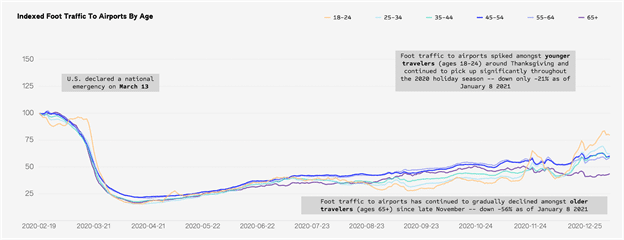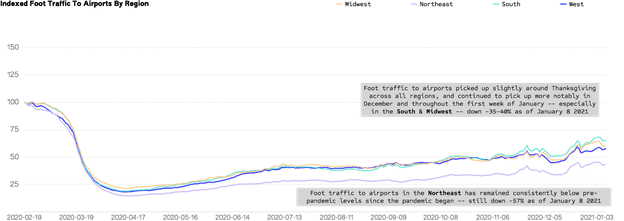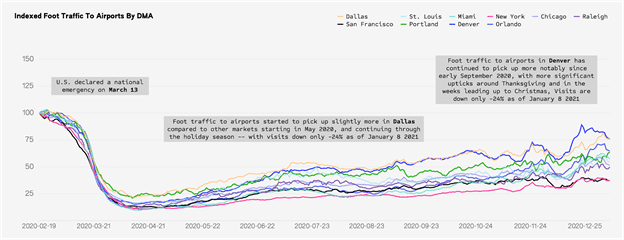Typically the busiest travel period of the year, the holiday season looked a bit different in 2020, with many Americans staying home and avoiding crowded airports due to the COVID-19 pandemic.
Yet after eight months of dramatically low levels of foot traffic to airports and hotels, travelers still turned out in droves for the 2020 holiday season, with visits to airports in Denver, for example, down only -13% as of Christmas Eve (compared to being down -42% as of November 1 2020).
While many people are likely to reduce their travel plans once more now that the holidays have passed and the coronavirus pandemic continues, here are four lessons to glean from the 2020 holiday travel trends that can inform 2021 marketing strategies:
1. Women & younger consumers are now traveling slightly more than men & older consumers.
Hotel visits have picked up slightly more amongst women than men since the pandemic began, perhaps indicating that female travelers are more likely to book full-service accommodations versus booking private homes (via services like Airbnb) or staying with friends or family during the pandemic. Hotel visits in general picked up most significantly amongst younger travelers (ages 18-24) during the holidays — down only -11% as of New Year’s Day compared to -33% amongst older travelers, ages 65+.
Unsurprisingly, airports saw a significant spike in foot traffic amongst younger travelers, ages 18-24 around Thanksgiving and Christmas, with visits down only -21% amongst this audience as of January 8, 2021 compared to -56% amongst older travelers, ages 65+.
Takeaway: While it may be awhile before the travel industry bounces back to pre-pandemic activity, there may be an opportunity for marketers to appeal to younger, female travelers and other groups that are already beginning to head back to hotels and airports.


2. Many travelers are still traveling by car vs. flying.
Road trips and local getaways have grown in popularity since the pandemic began. This is evident in the ongoing spike in foot traffic to gas stations, which remains well above pre-pandemic levels and which climbed even higher in December. During the holidays, travelers who visited a hotel were also more likely to visit rental car locations (+25%), RV Parks (+25%) and rest areas (+25%) compared to the average American.
Takeaway: As the pandemic continues, we will likely see many travelers continue to travel by car, taking local weekend getaways. Marketers can capitalize on this trend by using location data to identify roadtrippers, intercepting them when they’re in planning mode, or delivering tailored messaging while they’re on the road via billboard or audio advertisements.
3. Consumers are traveling more by plane in the South and Midwest, and less in the Northeast and West.
Not all consumers traveled by car during the holidays. In fact, consumers who visited a hotel during the holiday season are also more likely to visit airports (+33%) and travel lounges (+29%) compared to the average U.S. consumer.
However, consumers in some regions are more likely to travel by plane compared to other regions since the pandemic began. Foot traffic to airports (as well as hotels) in the South and Midwest picked up most notably during the holidays, with visits down only -32-35% as of January 3 (vs. being down -61-62% as of July 1 2020). In fact, foot traffic to airports in some markets has continued to pick up beyond the holiday season, with visits to airports in Dallas down only -24% as of January 8 (vs. being down -54% as of July 1 2020).

In contrast, consumers in the West and Northeast appear less likely to travel by plane since the pandemic began. Foot traffic to airports in these regions has remained well below pre-pandemic levels since early March 2020, with only minor upticks in traffic during the holiday season. Visits to airports in popular tourist destinations such as San Francisco and New York City remain down -63% as of January 8 2021.

Takeaway: Marketers should customize strategies by region, focusing on local getaways amongst consumers in the Northeast and West, and using different messaging for consumers in the Midwest and South, who may be more likely to travel by plane.
4. Whether traveling by car or by plane, it’s clear that consumers were eager to embrace the outdoors this holiday season, flocking to beaches and snowy destinations.
Ski vacations remain popular amongst winter travelers through the pandemic, suggesting travelers are itching to get outdoors. Holiday season hotel goers were also more likely to visit ski lodges (+50%), ski areas (+48%), ski chalets (+39%) and mountains (+24%) compared to the average U.S. consumer.
Others may opt for a warmer weather vacation to escape the cold. Consumers who visited a hotel in the past two months are more likely to visit surf spots (+32%), beaches (+28%) and islands (+26%) compared to the average American.

Takeaway: Once you’ve identified snow-lovers or beach-goers, reach them with a range of messages, including inspirations for their next getaway or useful vacation products (e.g. sunscreen).
2020 may be in the rearview mirror, but there is still a lot to be learned from consumers’ holiday behaviors during the first few months of 2021. With Spring still a few months away, many consumers will still be searching for pandemic-safe destinations and travel plans. Data, including location data, can help marketers identify these consumers and reach them where they are most likely to wander.
Note on methodology: We looked at indexed foot traffic trends from mid-February 2020 through January 8 2021, with a focus on the 2020 holiday season (November 2020 through January 8 2021).




